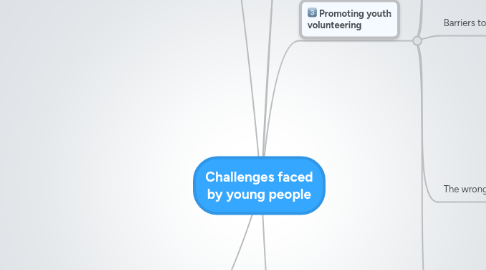
1. High youth unemployment
1.1. 'Internal' factors (issues for YP)
1.1.1. 'Normal culture'
1.1.1.1. Negative perception of youth
1.1.1.2. 'Lost generation' culture
1.1.2. Networks
1.1.2.1. Isolation
1.1.2.2. Low community engagement
1.1.2.3. Online vs Offline culture and profiles
1.1.2.4. Positive & negative engagement with peer group
1.1.2.5. Lack of awareness of social capital and skills to harness that potential
1.1.3. Incentives
1.1.4. Education
1.1.4.1. Lack of intra-personal skills
1.1.4.2. Taking online profile in the physical world
1.1.4.3. Dropping out of education
1.1.4.4. Relevance of education & training to real world opportunities
1.1.5. Individual wellbeing
1.1.5.1. Low aspirations
1.1.5.2. Mental health
1.1.5.3. Perception of low opportunities
1.1.5.4. Lack of self-value - not treated as assets
1.2. Digital approaches need to respond to the interaction between a young person's internal states and how that determines interaction with their environment and how their environment determines their internal states. Digital solutions need to work with that cycle.
1.3. External factors
1.3.1. Politics + power
1.3.1.1. Power remains with the government
1.3.1.2. Society is vulnerable and power balance between government & communities can be fracturing
1.3.2. Local environment
1.3.2.1. Local industrial decline
1.3.2.2. Local culture and attitudes
1.3.2.3. Locally specific challenges & opportunities
1.3.2.4. How does the specific location and local environment determine challenges and opportunities to employment?
1.3.3. Global economic situation
1.3.3.1. Lack of jobs available
1.3.3.2. Government policy (e.g. public sector cuts)
1.3.4. Personal relationships
1.3.4.1. Lack of role models
1.3.4.2. Lack of advocates for youth
1.3.4.3. 'Poor' parenting and strong family base
2. Promoting youth entrepreneurship
2.1. Lack of skills & knowledge
2.1.1. Business management skills and new obligations
2.1.2. Understanding the young person's role within a new enterprise. What they can do vs what they can get other people to do (such as outsourcing accounts)
2.1.3. Harnessing existing tools such as Facebook and Twitter and using those skills for enterprise.
2.1.4. Lack of opportunities to give young people the experience of taking theoretical knowledge into 'on the group' work.
2.1.5. Lack of skills and training for young people to learn new skills that are needed to run a business
2.1.6. "If you start another training course, something has gone wrong. That's not working and never has."
2.2. Personal barriers
2.2.1. Lack of confidence to take the risk of setting up an enterprise
2.2.2. Perception of restrictions - particularly financial and legal - rather than concrete barriers
2.2.3. Mindset to work flexible and collaboratively but lacking structures to support that
2.2.4. Knowing you can start your own business
2.2.5. Supporting young people's motivations for different ways of working
2.3. Understanding the finances
2.3.1. Perception of challenges of sourcing money for starting up
2.3.2. Low awareness of options such as micro-finance or crowdsourcing
2.3.3. Benefit system doesn't support transition to self-employed status without loss of benefits. Needs to support the 'freedom to fail' and encourage entrepreneurial thinking.
2.3.4. Fear of no guaranteed income - particularly during start up phase.
2.3.5. Flexibility in availability of money and funding. Supporting start ups as well as established businesses
2.4. Lack of flexibility
2.4.1. How do we link supply and demand in a way that works for young people?
2.4.2. Lack of support and understanding for different models of working from loose collaboration, portfolio working, freelancing, cooperatives, etc.
2.4.3. How we enable this flexibility to take place? How do we support young people to embrace this flexible way of working?
3. See http://www.socialreporters.net/?cat=34 for more...
4. Promoting youth volunteering
4.1. Not enough opportunities for diverse groups of young people
4.1.1. Diversity of interests, needs and motivation which also change over time
4.1.2. Support, services & resources need to meet the diversity
4.1.3. Lack of understanding to design opportunities responding to motivations and understanding why young people want or need to get involved
4.2. Low awareness of opportunities
4.2.1. Poor promotion of opportunities
4.2.2. Low awareness that there are opportunities at all
4.2.3. Low confidence
4.3. Barriers to involvement
4.3.1. Low credibility of available activities
4.3.2. The wrong incentives
4.3.3. The timing of activities
4.3.4. Motivations change over time and incentives need to adapt to that
4.4. The wrong opportunities
4.4.1. Is a focus on volunteering useful?
4.4.2. Focus on 'social valuable activity' instead of volunteering
4.4.2.1. Wikipedia is e.g. of socially valuable activity
4.4.2.2. How do we link intrinsic motivation and socially valuable activities
4.4.2.3. Highlight the social valuable activities that link to the interests of young people.
4.5. Need to 'give a digital space a physical home' to change the way we think communities are. Need to consider networks of interest, geographic focus, online / offline.
5. Youth exclusion from local decision making
5.1. Culture of exclusion
5.1.1. 'Them and us' mentality to community decision making
5.1.2. Divide between generations
5.1.3. Hard to engage even in established youth / youth focused organisations
5.1.4. Hard to break into established groups / networks / decision making bodies and have influence within them
5.1.5. Sometimes 'who you know' rather than an availability of all to be involved
5.2. Lack of awareness of opportunities
5.2.1. Lack of knowledge about how to get involved in decision making in a local area
5.2.2. Youth workers need to be digitally savvy to promote opportunities to young people
5.3. Diversity of young people involved
5.3.1. How do we reach the 'real' young people? Those who are traditionally excluded even from formal youth participation structures.
5.3.2. Need to build relationships with young people in communities to connect with 'real' youth
5.3.3. Young people need the opportunity to talk about the issues that matter to them, not consultation on the issues that adults think affect them.
